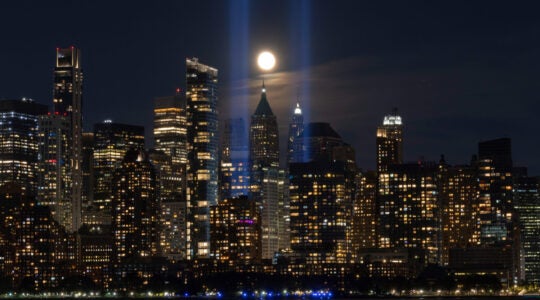The 1967 Israeli-Arab war broke out on the eve of finals week, in early June, when I was a student at Yeshiva University. I admit that one of my first responses to the dramatic radio bulletins I listened to in my dorm room was a fleeting prayer — that exams be canceled.
Don’t misunderstand. Of course I was concerned about the fate of my fellow Jews. I had been following the dire news for several weeks as Egyptian President Nasser ramped up his threats to drive the Jews into the sea. With the prospects of an imminent war growing, I had marched with pride at the especially large and fervent Israel Day parade down Riverside Drive the Sunday before, and joined my fellow students in prayer in the tense days leading up to the conflict.
But at the time I didn’t really think of Israelis as my brothers and sisters. More like distant cousins. I didn’t personally know anyone who lived in Israel. I had met very few Israelis. And I didn’t know many people who had ever been to Israel.
While thousands of young people around the country were inspired by religious and secular Zionist camps and youth groups, I don’t think my experience was that unusual 50 years ago for many American Jews, especially those of us who grew up outside of major Jewish communities like New York.
In those days our “flat,” interconnected world was very round. Long-distance travel was arduous and less common. When I was very young, the voyage to Israel was still made by ship and measured in days, not hours. Air travel became more popular in the 1960s, but trans-Atlantic flights were costly. And growing up in a small town in Maryland, I was far removed from a robust Jewish community. The Israel I was familiar with was more ancient than contemporary. It was the yearning for a restored Jerusalem of my daily prayers. But that was a call for the restoration of the Temple and its ritual sacrifices, not something I related to, and it was the Israel of the biblical stories I read in Hebrew school, where wars were fought with spears (and a timely slingshot) rather than tanks and artillery.
The only taste of modern-day Israel I had was from the World Over, the Jewish equivalent of The Weekly Reader, with illustrated stories about children in shorts and kova tembel hats (the Israeli national symbol), often shown discussing events while kicking a ball in the fields.
I couldn’t relate. I preferred baseball — the game and the caps.
For American Jews today, whether as supporters or critics, Israel is a reality in their lives, and an indicator of their Jewish identity, no longer the distant dot on the map it was when I was growing up.
Even when I left public school after sixth grade and attended a yeshiva in nearby Baltimore, the rabbis were more fluent in Yiddish than Hebrew, and spoke of their native European countries, not Israel. Modern Zionism was not part of the curriculum and not part of the discussion.
The one childhood experience that made Israel real for me was when I was about 14 and my parents made their first trip to the Jewish state as part of a rabbinic convention they attended.
They came back talking about their experience — the first time I recall Israel as part of our conversations at home — and with scores of color slides my dad took of Israeli scenes and landmarks. My parents began inviting groups of congregants to our house for scheduled showings of the slides, since hardly any of the members had been to Israel, and I began to learn about places like the Knesset, the Jerusalem Windmill and the King David Hotel. (Remember that the Western Wall was in Jordanian hands and off limits then.)
What struck home, though, were shots inside a makolet (small grocery store) with Hebrew writing on the jars of jelly and boxes of cereal. I began to think of Israel as a bustling, real-life society, not just a repository of biblical relics.
But it was the 1967 War that profoundly changed my identity as a Jew, and how I related to Israel.
During those dramatic six days, as tiny Israel, under threat of extinction from far larger forces on three fronts, prevailed and subdued the enemy, the events seemed nothing short of miraculous to me, and to millions of others. When we heard that IDF soldiers in Jerusalem had secured the Old City, and saw photos of Rabbi Shlomo Goren sounding the shofar at the Kotel, the significance of that new reality was profound. Israel had not just won the war, it had done so overwhelmingly, taking on new land and reunifying Jerusalem for the first time in many centuries. It had also won the hearts of diaspora Jews in a new and deeper way.
Suddenly, Israel was a source of great pride and admiration, and not just for Jews.
The problematic aspects of such a lopsided victory — the consequences of the humiliation of and responsibility for so many Arabs and the acquisition of additional land — were little considered in the euphoric aftermath.
Suddenly, Israel was a source of great pride and admiration, and not just for Jews. Major U.S. newspapers and magazines described Israel’s victory enthusiastically in David vs. Goliath terms, and its soldiers and leader were perceived as Super Jews.
American Jews had supported Israel generously in financial terms in its founding and early years. During the Six-Day War, they responded in unprecedented ways. At night, YU students would take the subway to Times Square and unfurl a large Israeli flag on the sidewalk as theatergoers, emerging from Broadway shows, emptied their wallets on the spot.
But the response transcended dollars; it went to a more intense, emotional level with renewed interest in Israel and an inner sense of connection for countless diaspora Jews, stirred by the drama of the war and the realization of how close Israel came to being destroyed.
Years later, when I visited Israel for the first time, at 27, as part of a mission for Jewish journalists, I felt a part of me was coming home. Since then, having made the trip more than two dozen times, I cherish the strong bonds to the land and the people that are personal as well as professional, and my commitment to Israel is an integral part of who I am as a Jew.
Still, for American Jews today, whether as supporters or critics, Israel is a reality in their lives, and an indicator of their Jewish identity, no longer the distant dot on the map it was when I was growing up. By now, largely through the success of Birthright Israel, about half of all diaspora Jews between the ages of 18 and 26 have visited Israel — a remarkable achievement. But Israel, once the great unifier in our society, has become a source of division and debate, chiefly over its policies regarding the Palestinians. In the Orthodox community the ties to Israel are stronger than ever. But in the liberal denominations, and especially among the young and unaffiliated, the perception of Jerusalem’s policies as illiberal are cause for concern and frustration, if not opposition.
The New York Jewish Week brings you the stories behind the headlines, keeping you connected to Jewish life in New York. Help sustain the reporting you trust by donating today.





